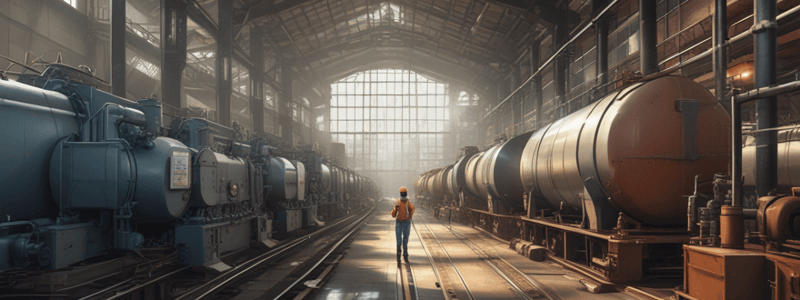Podcast
Questions and Answers
What is the primary objective of estimating in engineering and manufacturing?
What is the primary objective of estimating in engineering and manufacturing?
- To maximize the profitability of a project
- To predict the financial requirements of a project (correct)
- To minimize the project timeline
- To enhance the quality of the project
Which of the following is NOT a function of estimating?
Which of the following is NOT a function of estimating?
- Resource planning
- Quality control (correct)
- Cost tracking
- Budget preparation
What is the primary benefit of accurate estimating in terms of resource planning?
What is the primary benefit of accurate estimating in terms of resource planning?
- To increase profitability
- To ensure availability of necessary resources (correct)
- To reduce labor costs
- To improve the project timeline
Why is estimating important for competitive bidding?
Why is estimating important for competitive bidding?
What is the primary outcome of accurate estimating in terms of time management?
What is the primary outcome of accurate estimating in terms of time management?
What is the primary reason for estimating in terms of profitability analysis?
What is the primary reason for estimating in terms of profitability analysis?
Which of the following is a benefit of estimating in terms of decision making?
Which of the following is a benefit of estimating in terms of decision making?
What is the primary objective of cost tracking in estimating?
What is the primary objective of cost tracking in estimating?
Which of the following is NOT an objective of estimating?
Which of the following is NOT an objective of estimating?
What is the primary benefit of accurate estimating in terms of cost control?
What is the primary benefit of accurate estimating in terms of cost control?
What is the primary purpose of reviewing the work breakdown structure in the estimation process?
What is the primary purpose of reviewing the work breakdown structure in the estimation process?
Why is accurate weight estimation crucial in structural design?
Why is accurate weight estimation crucial in structural design?
What is the primary purpose of creating a Bill of Materials (BOM)?
What is the primary purpose of creating a Bill of Materials (BOM)?
Why is accurate estimation of machining time vital for production planning?
Why is accurate estimation of machining time vital for production planning?
What is the purpose of applying the material density in weight estimation?
What is the purpose of applying the material density in weight estimation?
What is the benefit of reviewing project specifications in material estimation?
What is the benefit of reviewing project specifications in material estimation?
Why is adding a waste factor important in material estimation?
Why is adding a waste factor important in material estimation?
What is the purpose of operation analysis in machining time estimation?
What is the purpose of operation analysis in machining time estimation?
Why is accurate estimation of material weights vital in cost calculation?
Why is accurate estimation of material weights vital in cost calculation?
What is the primary purpose of peer reviews and validation checks in the estimation process?
What is the primary purpose of peer reviews and validation checks in the estimation process?
What is the primary objective of Performance Measurement in estimating?
What is the primary objective of Performance Measurement in estimating?
Which of the following principles of estimating is most concerned with the reliability of estimates?
Which of the following principles of estimating is most concerned with the reliability of estimates?
What is the most significant factor affecting the accuracy of estimates in a project with complex technical requirements?
What is the most significant factor affecting the accuracy of estimates in a project with complex technical requirements?
What is the primary purpose of Quantity Takeoff in the estimating procedure?
What is the primary purpose of Quantity Takeoff in the estimating procedure?
Which of the following is a key factor in maintaining consistency in estimating across different projects?
Which of the following is a key factor in maintaining consistency in estimating across different projects?
What is the primary goal of Resource Allocation in estimating?
What is the primary goal of Resource Allocation in estimating?
What is the most significant factor affecting the accuracy of estimates in a project with frequent changes in scope?
What is the most significant factor affecting the accuracy of estimates in a project with frequent changes in scope?
What is the primary objective of process planning?
What is the primary objective of process planning?
What is the primary purpose of Costing in the estimating procedure?
What is the primary purpose of Costing in the estimating procedure?
Which of the following is NOT a key step in fabrication cost estimation?
Which of the following is NOT a key step in fabrication cost estimation?
What is the primary purpose of including overhead costs in cost estimation?
What is the primary purpose of including overhead costs in cost estimation?
Which of the following is a key principle of estimating that ensures estimates remain relevant and accurate throughout the project lifecycle?
Which of the following is a key principle of estimating that ensures estimates remain relevant and accurate throughout the project lifecycle?
What is the primary objective of Project Scheduling in estimating?
What is the primary objective of Project Scheduling in estimating?
Which of the following is a key component of foundry cost estimation?
Which of the following is a key component of foundry cost estimation?
What is the primary advantage of following a systematic estimating procedure?
What is the primary advantage of following a systematic estimating procedure?
Which of the following is a factor influencing estimating in engineering and manufacturing?
Which of the following is a factor influencing estimating in engineering and manufacturing?
What is the primary purpose of estimating in engineering and manufacturing?
What is the primary purpose of estimating in engineering and manufacturing?
Which of the following is NOT a step in forging cost estimation?
Which of the following is NOT a step in forging cost estimation?
What is the primary purpose of tooling costs in forging cost estimation?
What is the primary purpose of tooling costs in forging cost estimation?
Which of the following is a key component of fabrication cost estimation?
Which of the following is a key component of fabrication cost estimation?
Flashcards are hidden until you start studying
Study Notes
Objectives of Estimating
- Estimating helps in predicting financial requirements of a project, ensuring it remains within the budget and avoiding cost overruns and financial losses.
- Estimating identifies resources needed for a project, including materials, labor, and machinery, ensuring all necessary resources are procured and available when required.
- Accurate estimates enable effective scheduling, ensuring projects are completed within stipulated timelines.
- Estimating allows for evaluating potential profitability of a project by comparing estimated costs with expected revenue.
- Accurate estimates provide essential data for making informed decisions regarding project feasibility, scope, design, and resource allocation.
- Detailed and accurate cost estimates are crucial for preparing competitive bids for contracts.
Functions of Estimating
- Estimating develops detailed budgets outlining expected costs associated with a project.
- Estimating involves monitoring and controlling costs throughout the project lifecycle to prevent budget overruns.
- Estimating ensures all necessary resources are identified and procured in a timely manner.
- Estimating creates timelines that align with resource availability and project deadlines.
- Estimating identifies potential cost risks and develops strategies to mitigate them.
- Estimating compares actual costs against estimates to assess accuracy and improve future estimates.
Principles of Estimating
- Estimates must be as precise as possible, based on reliable data and sound judgment.
- The estimating process should follow standardized procedures to ensure uniformity across different projects.
- The methodology and assumptions used in estimating should be clearly documented and communicated.
- Estimating methods should be flexible enough to accommodate changes in project scope, design, or market conditions.
- Comprehensive records of estimates, including all assumptions and calculations, should be maintained for future reference and analysis.
Principle Factors of Estimating
- Project complexity can affect the accuracy and reliability of estimates.
- Clear and detailed project specifications lead to more precise estimates.
- Fluctuations in material prices can impact cost estimates significantly.
- Variations in labor costs, including wages, benefits, and productivity, influence estimates.
- The availability and efficiency of machinery and technology can affect time and cost estimates.
- Market conditions, such as supply and demand, can impact material and labor costs.
- Historical data can provide valuable insights for future estimates.
Estimating Procedure
- The estimating procedure involves project analysis, quantity takeoff, costing, time estimation, overhead and profit, review and validation, and documentation and reporting.
- Project analysis reviews project specifications, drawings, and requirements to understand the scope and objectives.
- Quantity takeoff measures and lists all materials, components, and labor required for the project.
- Costing assigns costs to each item on the quantity takeoff list based on current prices and rates.
- Time estimation calculates the time required to complete each task and stage of the project.
- Overhead and profit add indirect costs and desired profit margins to the estimate.
- Review and validation check the estimate for accuracy, completeness, and reasonableness.
- Documentation and reporting prepare detailed estimate reports for review and approval by stakeholders.
Estimation of Weights & Materials
- Weight estimation is essential in engineering and manufacturing, particularly for structural components, machinery, and transportation projects.
- Accurate weight estimation helps in structural design, transportation planning, and cost calculation.
- The process involves material selection, volume calculation, density application, and documentation.
Estimation of Machining Time
- Estimating machining time involves calculating the time required to perform various machining operations.
- Accurate time estimation is vital for production planning, cost estimation, and resource allocation.
- The process includes operation analysis, process planning, cutting parameters, and time calculation.
Estimation of Fabrication Cost
- Fabrication cost estimation involves determining the total cost to produce a component or assembly, including materials, labor, overhead, and profit margins.
- Key steps include material costs, labor costs, overhead costs, and profit margin calculation.
Estimation of Forging Cost
- Forging cost estimation involves calculating the expenses associated with the forging process, including material, labor, and overhead.
- Key steps include material costs, energy costs, labor costs, tooling costs, and overhead costs calculation.
Estimation of Foundry Cost
- Foundry cost estimation involves calculating the expenses related to casting processes, including material, labor, and overhead.
- Key components include material costs, mold costs, energy costs, labor costs, and overhead costs.
Studying That Suits You
Use AI to generate personalized quizzes and flashcards to suit your learning preferences.





